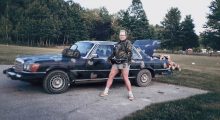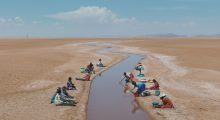Cinematographers
Interviews - Cinematographers
-
“It Was So Physically Demanding That It Almost Killed the Three of Us”: DP Aaron Moorhead on Something in the Dirt

Something in the Dirt is the fifth film that Justin Benson and Aaron Moorhead have directed together, but this one is paradoxically the most ambitious and the most intimate. Shot during the COVID pandemic, it by necessity made almost entirely by Benson and Moorhead, as well as their producer, David Lawson, and a production designer, Ariel Vida. Below, Moorhead discusses how they incorporated the isolation mandated by COVID into the film and disguised the conditions of the shoot with a bit of movie magic. Filmmaker: How and why did you wind up being the cinematographer of your film? What were […]
-
“My Goal for This Film Was to Combine Two Completely Distinct Styles in a Way that Seamlessly Tells the Story”: DP Alan Gwizdowski on Honk For Jesus. Save Your Soul

In Honk For Jesus. Save Your Soul combines faux-documentary and straightforward cinematic narrative styles to tell the story of a couple attempting to rebuild the congregation at their once-thriving megachurch in the aftermath of a scandal. Cinematographer Alan Gwizdowski discusses how he combined the two styles in a way that was intuitive for the audience while emphasizing the ambiguities of the narrative and the film’s critique of documentary filmmaking. Filmmaker: How and why did you wind up being the cinematographer of your film? What were the factors and attributes that led to your being hired for this job? Gwizdowski: Another cinematographer, Adam Bricker, […]
-
“It’s a Lot Easier to Make a Genuine Connection With Someone Without a Whole Bunch of Gear in Between You and Them”: DPs Zac Manuel & Justin Zweifach on Descendant

Just north of Mobile, Alabama is the historic community of Africatown founded by 32 West Africans who were transported to the US on the Clotilda, the last known slave ship to enter the country. Margaret Brown’s Descendant tells the story of the descendants who still reside in Africatown, as well as of the persistent power imbalance between the descendants of the slaves and the descendants of the Meaher family that chartered the expedition, who today own much of the industrialized land and factories around Africatown. Cinematographers Justin Zweifach and Zac Manuel discuss what they learned making the film and how they […]
-
“I Wanted the Cinematography to Take a Backseat to the Story and Main Character”: DP Adam Stone on 2nd Chance

2nd Chance continues director Ramin Bahrani’s concern with people on the margins of society pursuing the American Dream. The documentary examines the case of Richard Davis, a bankrupt pizzeria owner who invented the bulletproof vest, only to find his reputation sullied after a defective product led to the death of a police officer. Below, cinematographer Adam Stone explains how the intrigue of the subject led him to take a hands-off approach that emphasized character and narrative rather than style. Filmmaker: How and why did you wind up being the cinematographer of your film? What were the factors and attributes that led […]
-
“There Is Always Something to See, Something to Fear”: DP Jarkko T. Laine on Hatching

A lifestyle blog called “Lovely Everyday Life” run by the mother of a friendless tween sounds readymade for satire, and it is, but Hatching also takes it toward horror when the aforementioned tween nurtures and befriends the creature that emerges from a strange egg she finds in the woods. Cinematographer Jarkko T. Laine discusses shooting a horror film that takes place in well lit environs and the difficulties of working with animatronics. Filmmaker: How and why did you wind up being the cinematographer of your film? What were the factors and attributes that led to your being hired for this job? […]
-
“You Have to Find a Balance Between the Eroticism and the Reality”: Ashley Connor on Sharp Stick

For Sharp Stick, her first feature film since 2010’s Tiny Furniture, Lena Dunham relates the adventure of Sarah Jo, a 26-year-old virgin, as she woos the father of Zach, an intellectually disabled child for whom she cares. As the film unfolds, ideas about trauma, sex positivity and body image begin to emerge. Cinematographer Ashley Connor discusses shooting the film on an accelerated timeline and how she captured the feeling of infatuation in the visuals. Filmmaker: How and why did you wind up being the cinematographer of your film? What were the factors and attributes that led to your being hired […]
-
“Capturing the Scale of the Amazon Rainforest Is an Impossible Task”: DP Alex Pritz on The Territory

The Territory takes viewers deep inside the Brazilian Amazon, allowing them to bear witness to the ongoing conflict that has pitted Indigenous inhabitants against settlers looking to capitalize on the land. The film captures a pair of young leaders and their mentor, who defend the land with their lives, as well as settlers hoping to establish their own homestead, including those who engage in clear-cutting on their own. Director-cinematographer Alex Pritz explains how the film’s visual style distinguishes the different perspectives, his collaboration with an Indigenous cinematographer, and how his crew unexpectedly found themselves recording a settler burning down the […]
-
“It’s Always About Time and Not Having It”: DP Greta Zozula on Summering

With Summering, James Ponsoldt wanted to make a film that his young daughter would appreciate, and the result is a coming-of-age story about four girls planning one final weekend of fun before middle school. They unexpectedly make a discovery in the nearby woods that they keep to themselves, and from there imagination and reality collide in magical realist fashion. Below, cinematographer Greta Zozula explains how she managed the narrative’s tension between magic and realism and how the crew managed to make difficult scenes work with limited time. Filmmaker: How and why did you wind up being the cinematographer of your film? […]
-
“I Wanted to Restrict Lighting That Didn’t Feel Naturally Motivated”: DP Barton Cortright on The Cathedral

With The Cathedral, an unseen narrator relates the life of Jesse Damrosh, beginning with the dissolution of his parents’ marriage and highlighting other hallmarks of middle-class American existence. D’Ambrose lingers not on the big life events, however, but the more quotidian and quieter moments and objects that leave indelible marks on one’s memory. Cinematographer Barton Cortright explains why natural light was the correct approach for the film, and how he amplified the natural look to avoid a shallow depth of field. Filmmaker: How and why did you wind up being the cinematographer of your film? What were the factors and attributes […]
-
“The Challenges We Had Were All Related to Nature”: DP Barbara Alvarez on Utama

In Alejandro Loayza Grisi’s Utama, an ailing man tries to persuade his elderly Quechuan grandparents weathering a drought on the Bolivian Altiplano to move away from their lifelong home and join him in the city. Shot on location, the film portrays the daily routines and relaxed pace of life as well as the climate threat residents of the Bolivian highlands face. Below, cinematographer Barbara Alvarez recounts how the climate created difficulties in production and how she captured the tension between the harshness and the beauty of the location. Filmmaker: How and why did you wind up being the cinematographer of […]










